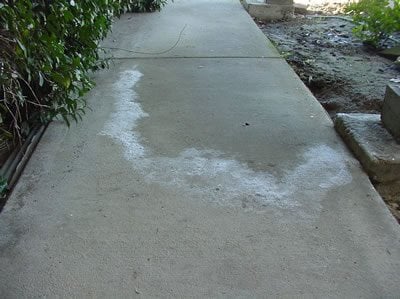- Colored Concrete Home
- Concrete Color Charts
- Ways to Color Concrete
- Concrete stains
- Integral Color
- Dry-Shake Color Hardener
- Concrete Dyes
- Concrete Paint
- Comparison Chart: Concrete Coloring Products
- Design Ideas for Colored Concrete
- Which Color Scheme is Right for Your Home?
- Creating color and texture with Stamped Concrete
- Adding Interest with Exposed Aggregate
- Creating Excitement with Color: Endless Possibilities with Polymer Stain
- Related Information:
- Problems with colored concrete: Common problems, why they occur, and how to avoid or fix them
- Guide to Buying Concrete Stains and Dyes
- Lea este artículo en español
Efflorescence on Black Concrete
Question:
Last week, we poured a band of integrally colored black concrete. It looked great for three days, but then it rained a little the night of the third day, and by the next morning all the black color had disappeared, hidden by a grayish-white surface discoloration. What happened, and how do I fix this?
Answer:
This is one of the most common but least understood phenomenons with concrete. Efflorescence is a chalky white salt residue that can occur with any product containing cement.
See our Complete Guide to Efflorescence
As moisture migrates up to the surface of the concrete, it carries along with it calcium salts from within the concrete. When the salts reach the surface, they react with CO2 in the air and form insoluble calcium carbonate. This white, dusty, scaly salt can be minimal or dramatic, depending on the amount of free calcium salt present in the concrete. Exposure to rain, standing water, and sprinklers only make the situation worse, as water triggers the reaction and creates more efflorescence.
Find contractors offering concrete cleaning near me.
Efflorescence is not as noticeable when it occurs on gray concrete, but even a little efflorescence on colored concrete can be a contractor's worst nightmare. Efflorescence makes red look pink, brown look tan, and black look gray or even white. The good news is that it will eventually go away on its own as the free calcium is depleted. The bad news is that this can take as long as 15 years. And in this situation, you can't wait.
To fix the problem at this point, clean the surface with a mild acid or efflorescence remover (some manufacturers make special efflorescence cleaners) followed by sealing. To avoid the problem altogether on future projects, consider using a colored curing compound or cure and seal to match the color of the concrete.
 Exterior Surface Cleaner
Removes efflorescence, cement film, lime and mortar residues.
Exterior Surface Cleaner
Removes efflorescence, cement film, lime and mortar residues.
 E-Etch®
Environmentally-friendly efflorescence remover.
E-Etch®
Environmentally-friendly efflorescence remover.
 Efflorescence Cleaner
Water soluble formula safe for indoor use.
Efflorescence Cleaner
Water soluble formula safe for indoor use.
To learn more about efflorescence, read my other posts: Fixing Stamped Concrete and Fixing Colored Concrete
Find Concrete Cleaner & Sealers
Author Chris Sullivan, ConcreteNetwork.com technical expert and vice president of sales and marketing for ChemSystems Inc.





